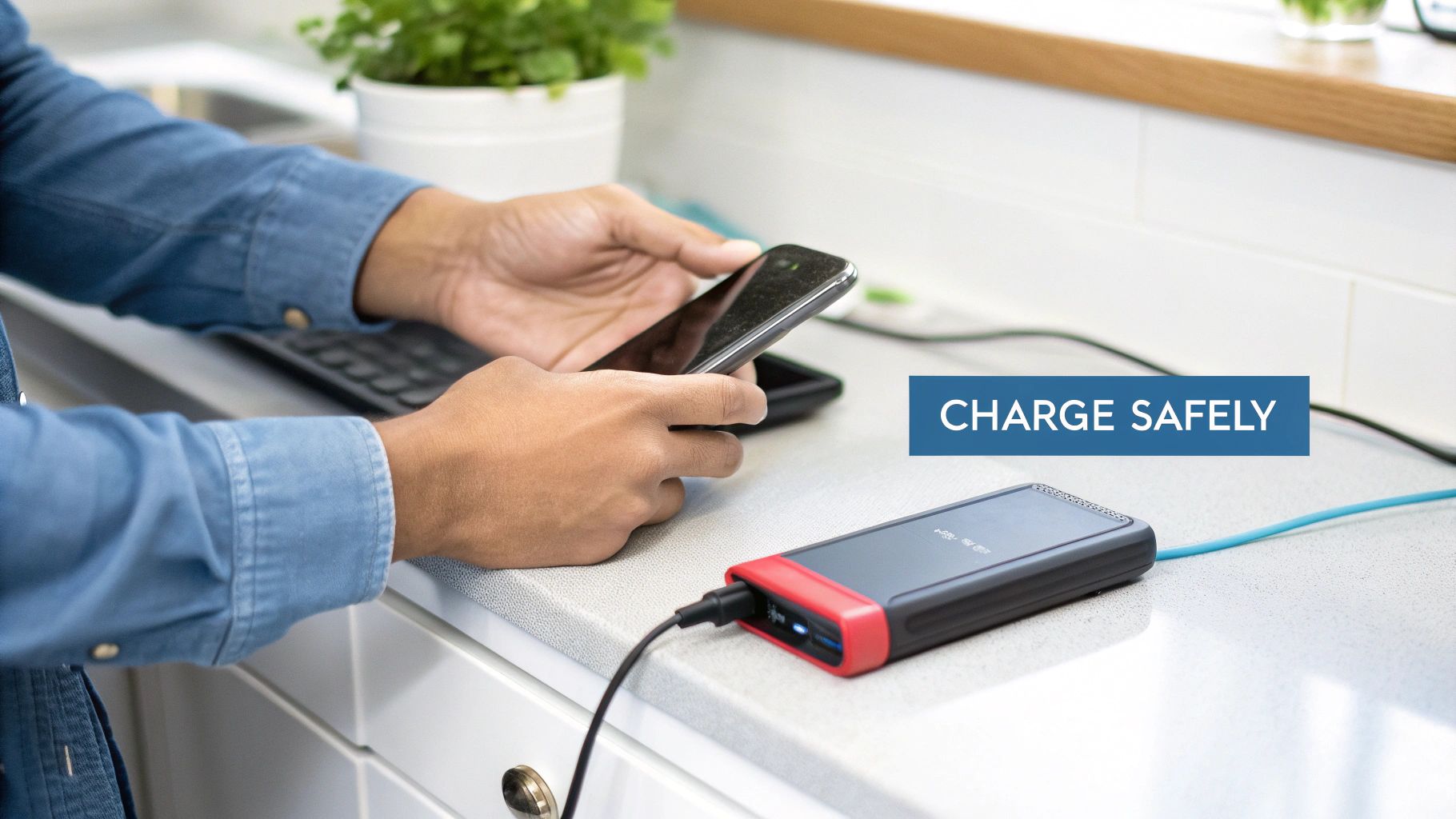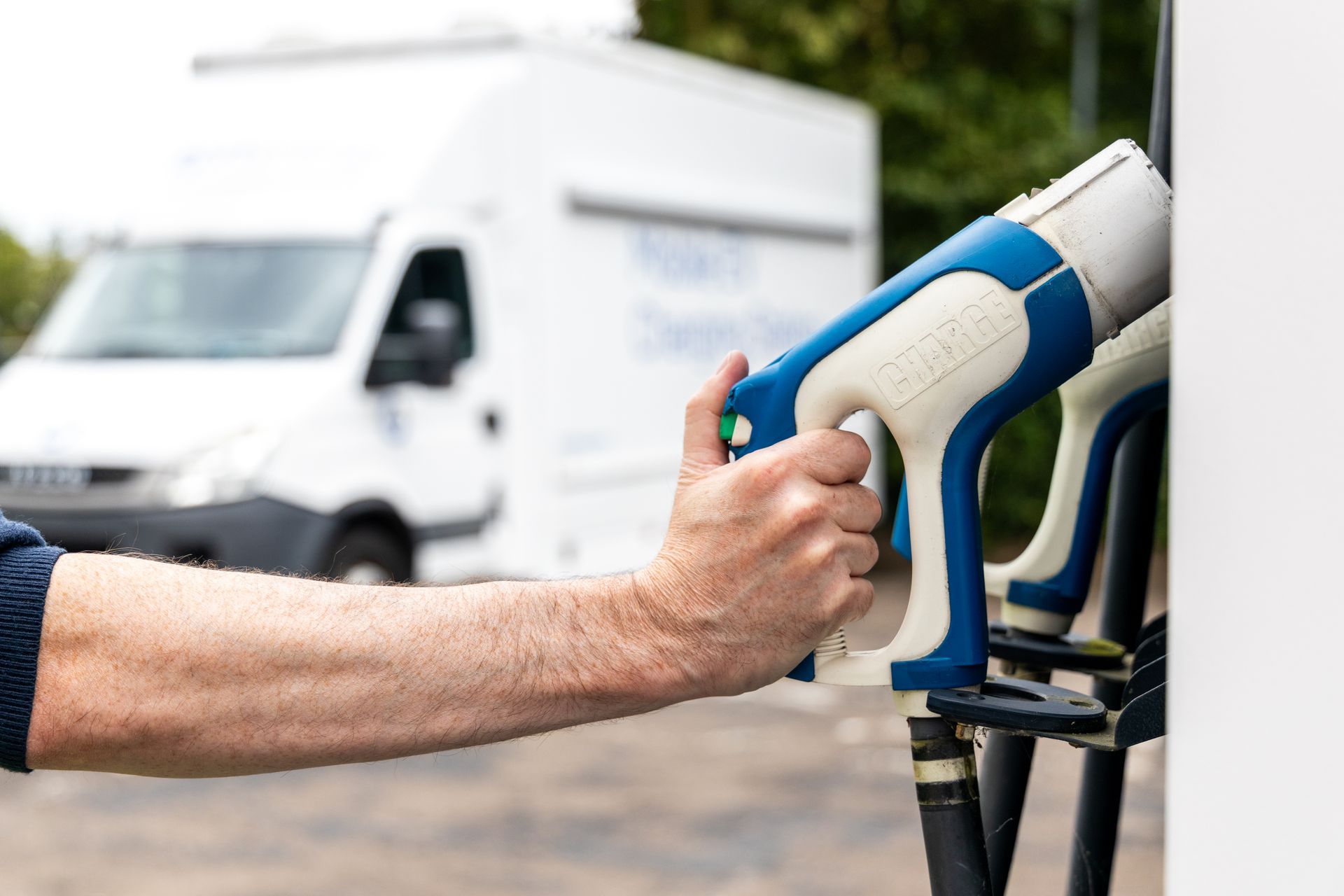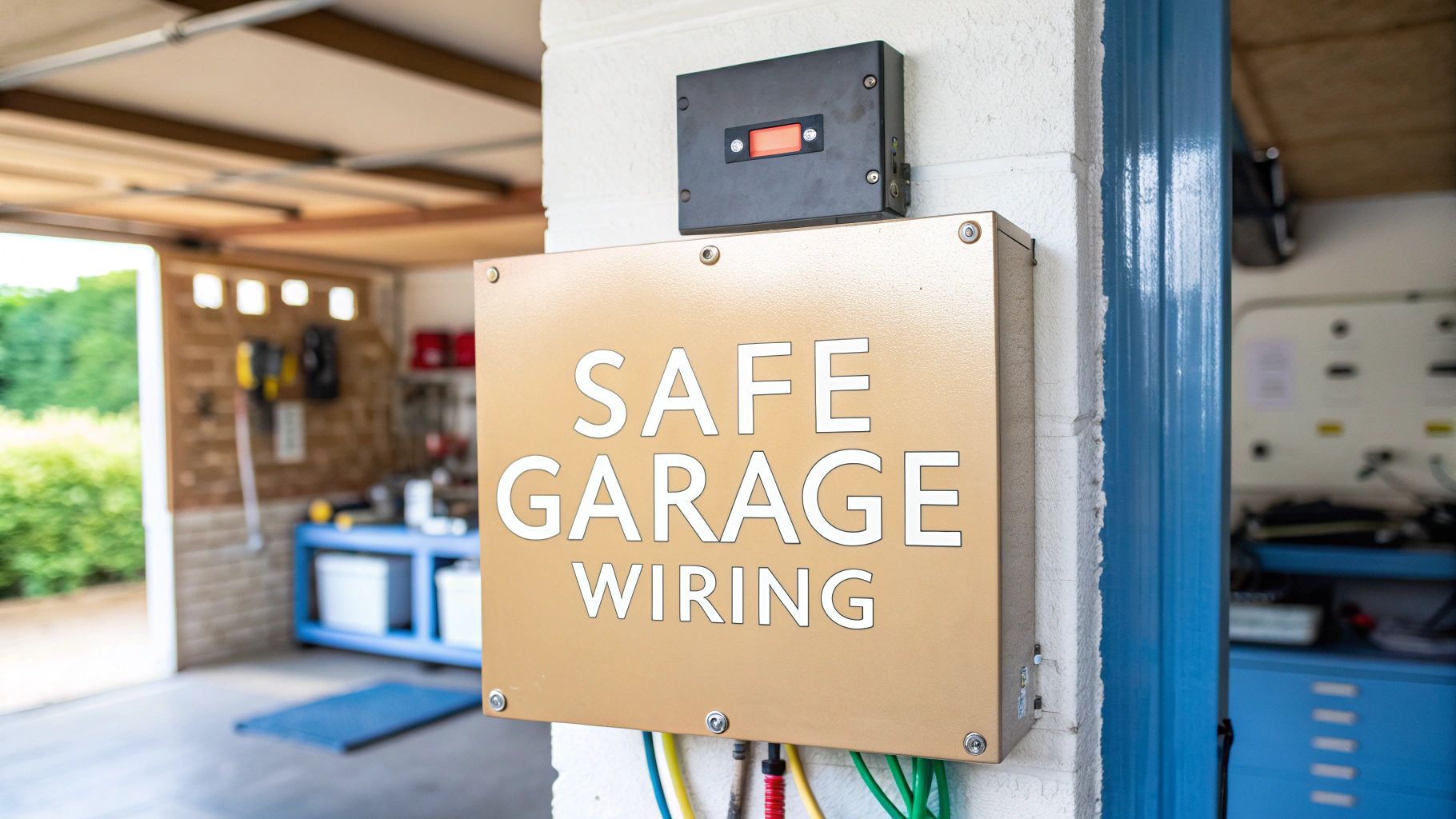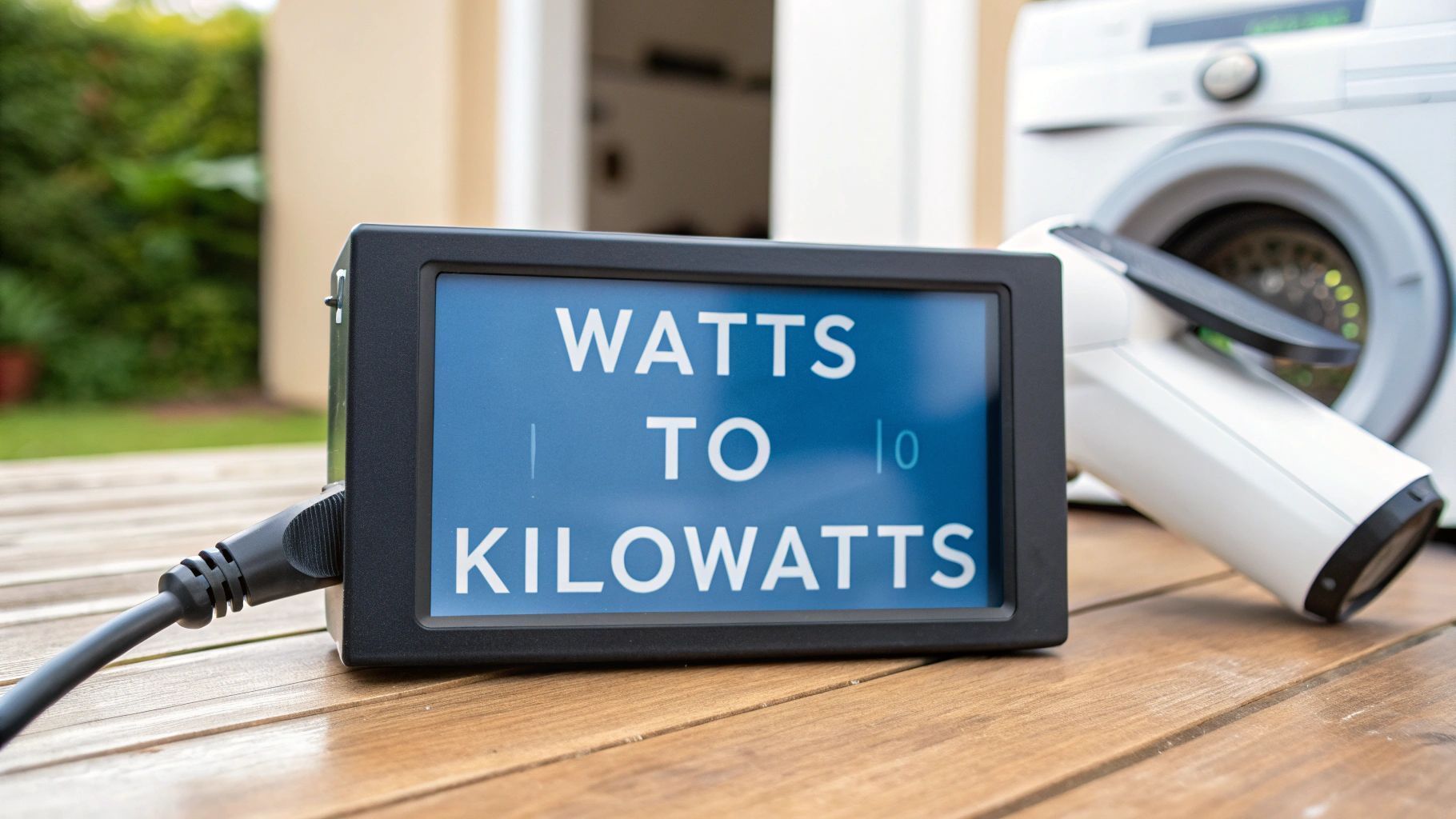How to Charge Lithium Batteries Safely and Efficiently
Knowing how to charge a lithium battery properly is about more than just plugging it in. It’s about using a compatible charger and following some simple safety rules to prevent damage and more importantly, reduce the risk of fire. That means always using the charger that came with your device or a certified equivalent. It also means never leaving a battery to charge unattended, especially overnight.
Why Safe Lithium Battery Charging Is More Critical Than Ever

From the smartphone in your pocket to the e-bike you ride to work, lithium batteries are the quiet workhorses of our modern lives. Their rise has been so swift that we've barely had time to consider the safety issues that come with them—and those concerns can't be ignored any longer.
The sheer convenience these batteries offer often makes it easy to forget the potential dangers of charging them incorrectly. Using a cheap, counterfeit charger, leaving batteries in hot or damp conditions or simply ignoring the warning signs can lead to catastrophic failures. These aren't just minor hiccups; they're real-world risks that demand our full attention.
The Alarming Rise in Battery-Related Incidents
Recent statistics paint a stark picture of just how big this problem has become here in the UK. The number of fires caused by lithium-ion batteries has surged. Between 2022 and 2024, these fires shot up by a staggering 93% . This isn't a coincidence; it's a direct result of the sheer number of devices we now rely on, from electric cars to personal mobility scooters.
This trend is especially worrying with e-bikes, which were responsible for 362 fires in 2024 alone . That’s more than double the 181 incidents recorded back in 2022. These figures aren't just numbers on a page; they represent a critical need for better public awareness and stricter safety practices.
The core of the problem often boils down to a simple lack of knowledge. Many people just don't realise that the cheap, uncertified charger they bought online could pose a serious threat to their home and their safety.
The Mobile Charging Solution
This growing safety crisis has, perhaps unsurprisingly, created a major opportunity for mobile charging operators. As more businesses and individuals wake up to the risks, the demand for professional, safe and certified charging services is on the rise. A mobile charging service offers a reliable and secure alternative to risky home charging setups, creating a significant business opportunity.
For an operator, this translates into a solid business model built on safety and convenience. Imagine offering a call-out service to fleet managers who need their delivery e-bikes charged safely or providing secure charging stations at big public events. The potential revenue streams are substantial and can generate a considerable income. For example, an operator charging a competitive rate of 70p per kWh could make £70 from a single 100kWh charging session. With multiple clients a day, the daily earnings can quickly reach hundreds of pounds, leading to a highly profitable venture.
- Pay-per-charge fees: A straightforward model where customers pay for each charge.
- Subscription services: Businesses can pay a monthly fee for regular, scheduled charging of their vehicle fleets.
- Emergency call-outs: A premium service for individuals or companies needing an urgent and safe power top-up.
By offering a professional service, an operator doesn't just generate a healthy income—they play a vital role in promoting safer battery habits. To really get to grips with the crucial aspects of handling these power sources, it’s worth digging deeper into Lithium Ion Batteries and Safe Battery Storage.
Choosing the Right Charger for Your Lithium Battery
Using the wrong charger isn’t just a minor mistake; it’s one of the quickest ways to damage your battery and create a serious safety hazard. The golden rule is simple: always prioritise the charger that came with your device .
If that’s lost or broken, your next choice must be a high-quality, certified replacement from a reputable manufacturer. Whatever you do, avoid the cheap, unbranded knock-offs you find on online marketplaces.
This isn’t just cautious advice. UK government research revealed a stark reality: 35% of Personal Light Electric Vehicle owners had bought separate, often uncertified, chargers or batteries. These users experienced safety incidents at a much higher rate than those who stuck with the original parts. The British Safety Council has also highlighted this issue, strongly advocating for using the proper, certified equipment.
Matching the Technical Specifications
When you're looking for a replacement, finding a charger with a plug that fits is nowhere near enough. You have to match the technical specifications exactly. Get this wrong and you're heading for trouble.
Here's what to check:
- Voltage (V): The charger's voltage output must match the battery's required voltage precisely. A higher voltage will overload and damage the battery’s internal cells, leading to overheating and a significant fire risk.
- Amperage (A): The amperage, or current, determines how quickly the battery charges. While a slightly lower amp rating might just charge the battery slowly, a charger with a much higher amperage can completely overwhelm the battery's management system.
Think of it like filling a water bottle. Voltage is the water pressure and amperage is the flow rate. Too much pressure (voltage) can burst the bottle, while too much flow (amperage) can make it overflow before you have a chance to stop it. For a deeper dive into how these chargers convert power, check out our detailed guide to AC to DC battery chargers.
To make it even clearer, here’s a quick checklist to run through before you plug anything in.
Charger Compatibility Checklist
Before you connect a charger to your valuable lithium battery, run through these simple checks. It takes just a minute but can save you from a costly and dangerous mistake.
| Check | What to Look For | Why It Matters |
|---|---|---|
| Voltage Match | Ensure the charger's output voltage ( V ) is identical to the battery's required input voltage. | Too high and you'll fry the cells. Too low and it won't charge at all. |
| Amperage Rating | The charger's amperage ( A ) should be equal to or slightly lower than the battery's recommended charge rate. | A significantly higher amperage can overwhelm the battery's protection circuits, causing dangerous overheating. |
| Certification Marks | Look for genuine CE , UKCA or other recognised safety certification marks. | These marks indicate the charger has been tested and meets essential safety standards, unlike cheap fakes. |
| Physical Condition | Check for frayed wires, cracked casing or bent pins. Never use a damaged charger. | Damaged equipment can short-circuit, posing both a fire and an electric shock risk. |
Getting these four things right is fundamental to charging safely and extending the life of your battery.
The Role of Smart Chargers
Thankfully, modern chargers offer a vital layer of protection. Known as smart chargers , they are designed specifically for lithium battery chemistry and follow a precise charging profile called Constant Current/Constant Voltage (CC/CV).
A smart charger actively communicates with the battery's internal Battery Management System (BMS). It automatically adjusts the current and voltage during the charging cycle, then shuts off completely once the battery is full. This prevents the single most common cause of battery failure: overcharging.
This intelligent process is something a basic, uncertified charger simply cannot do. A cheap charger will just keep pushing power into a full battery, causing it to overheat and swell—a classic warning sign of imminent failure.
Investing in a proper smart charger isn't an expense; it's essential insurance against a potential disaster. It’s the most important step you can take towards safe and effective battery charging.
Your Guide to the Correct Charging Process
Now that you’ve got the right equipment, let's walk through how to actually charge a lithium battery correctly. It’s a pretty straightforward process, but it hinges on a specific two-stage method called Constant Current/Constant Voltage (CC/CV). This isn't just a bit of technical jargon; it's the very reason why you must use a dedicated lithium charger for both safety and the battery's lifespan.
First up is the Constant Current phase. The charger pushes a steady, controlled stream of power into the battery. This is where the heavy lifting happens, quickly getting the battery to about 80% of its total capacity. Once it reaches a certain voltage, the charger intelligently switches over to the Constant Voltage phase. At this point, the voltage stays fixed while the current slowly tapers off until the battery is full. A proper smart charger then shuts itself down completely.
Creating a Safe Charging Environment
Where you charge is just as important as how you charge. You absolutely need a cool, dry and well-ventilated space. Critically, it must be clear of any flammable materials—think paper, fabrics or chemicals.
This is exactly why charging your e-bike battery on the living room sofa or a carpeted floor is a terrible idea. If the battery were to overheat and fail, those materials could ignite in an instant, turning a routine charge into a serious fire hazard. Always, always place both the battery and the charger on a hard, non-combustible surface, like a concrete garage floor or a tiled worktop.
The principles of safe charging environments apply across the board, from small power packs to the huge batteries in electric vehicles. If you're interested in the bigger picture, this guide on how to charge your electric car offers some great insights.
Choosing the right charger is the first step towards safe charging and this flowchart breaks down the key decisions.

As the visual guide shows, your default choice should always be the original charger that came with your device. If that’s not an option, the next best thing is a certified model that perfectly matches your battery's specs.
Best Practices for Battery Health
To really get the most out of your lithium batteries and keep them performing well for years, it pays to adopt a few smart habits. These simple tweaks can make a massive difference to your battery's overall lifespan.
- Avoid charging to 100% all the time. Constantly pushing a lithium battery to its absolute limit puts stress on the cells. For day-to-day use, charging to around 80-90% is much healthier and can literally double the number of charge cycles you get from it.
- Don't let it drop to zero. In the same way, completely draining the battery is tough on its internal chemistry. It's far better to plug it in for a top-up when it gets down to about 20-30% .
- Never leave it charging unattended. This is the golden rule of battery safety. Never, ever leave a battery charging overnight or while you're out of the house. Even with modern safety features, malfunctions can happen. Being there means you can act immediately if you notice it getting too hot or starting to swell.
Remember: A lithium battery is happiest when it's working in the middle of its charge range. Think of it like a muscle – constant extreme stretching or total exhaustion will wear it out much faster than moderate, regular use.
While the core principles for charging lithium-ion cells are pretty universal, the specifics can vary from older technologies. For instance, if you want to see how it differs from a traditional lead-acid battery, you can read more about how to charge a car battery at home in our quick UK guide.
How to Spot a Failing Lithium Battery

Knowing how to charge a lithium battery is only half the battle. Just as crucial is knowing when to stop—when the battery itself is telling you it’s done.
Catching a failing battery early can be the difference between a simple replacement and a fire. Think of it as a routine health check for your power source; a quick inspection can stop a problem before it becomes a disaster.
The most glaring warning signs are physical. A healthy battery should be solid and uniform. Any change in its shape is a massive red flag.
Telltale Physical Signs
Often, your own eyes and nose are the best tools you have for spotting a battery on its last legs. When the chemistry inside goes wrong, the signs are often impossible to miss.
Keep a close watch for these warning signs:
- Swelling or Bulging: This is the big one. If the battery casing looks puffy, bloated or like it's about to burst, that’s due to gas build-up from internal damage. It's a clear sign the cells have failed and the fire risk is significant.
- Strange Odours: A good battery has no smell. If you catch a weirdly sweet, metallic or sharp chemical scent, the cells could be leaking. Don't ignore it.
- Discolouration or Stains: Any odd stains, rust-like corrosion near the terminals or dark, burn-like marks on the casing are signs of overheating or a chemical leak.
- Leaking Fluid: This one is obvious but critical. Any liquid seeping out means the casing is breached. That fluid is corrosive and hazardous, so don’t touch it.
If you spot any of these physical symptoms, the battery is no longer stable. Continuing to use or charge it is incredibly dangerous.
Performance Red Flags
Sometimes, a battery can look perfectly fine on the outside while it’s failing internally. A sudden drop in performance is often the first clue that the chemistry is going south.
Pay attention to how your battery behaves. Any sudden, unexplained change is your signal that it’s time for a replacement.
A battery getting seriously hot to the touch during a normal charge cycle is a major warning. A little warmth is fine, but excessive heat means it’s struggling to take a charge safely and could be on the verge of thermal runaway.
You should also watch for these performance-based clues:
- Doesn't Hold a Charge: If a full battery dies way faster than it used to, its capacity has tanked.
- Takes Forever to Charge: A battery that suddenly takes much longer to reach full capacity is another sign of ageing or damaged cells.
- Fails to Charge Completely: If your battery never hits 100% , even after the right amount of time on the correct charger, its cells or internal management system are likely failing.
If you notice any of these physical or performance issues, your next steps are non-negotiable. Immediately stop using and charging the battery.
Disconnect it from everything, then move it to a safe, isolated, non-flammable spot—preferably outdoors and away from anything combustible. Never just toss it in the bin; it needs to be taken to a proper battery recycling facility for safe disposal.
The Mobile Charging Opportunity for UK Businesses
Beyond the immediate concerns for personal safety, the surge in lithium battery use has unlocked a massive commercial opportunity. For savvy UK entrepreneurs, the growing clamour for safe, certified and convenient power has created a market that's ripe for the picking. A mobile charging service isn't just a clever idea; it's a profitable business that solves a very real and growing problem.
This isn't about simply installing more fixed charging points. The real game-changer is taking power directly to where it's needed most. Picture a mobile charging van pulling up to a construction site brimming with cordless tools, a festival buzzing with electric buggies or a depot full of delivery e-bikes needing a safe overnight top-up. Each of these scenarios is a clear and direct revenue stream.
The financial upside is genuinely compelling. Operators can build a business with multiple income streams, giving them the flexibility to cater to different clients and maximise their earnings. By charging a competitive per-kWh rate, an operator can generate significant income from just a few call-outs per day, making it a lucrative full-time business.
Breaking Down the Revenue Potential
A mobile charging service is far more than a single-trick pony. A smart operator can build a robust business by blending different charging models, each tailored to a specific corner of the market.
Here are some of the most effective approaches we've seen work:
- Pay-per-Kilowatt-Hour: This is the most straightforward model. Just like a petrol station, you charge clients based on the precise amount of energy they use. It’s clean, transparent and incredibly easy for customers to grasp.
- Emergency Call-Out Fees: This is where you offer a premium, rapid-response service for businesses in a bind. A stranded delivery driver with a dead e-bike or a film crew whose equipment is dying will happily pay a premium to get back up and running.
- Subscription Models: For commercial fleets, a monthly subscription is the holy grail. It provides predictable, recurring revenue for you and a hassle-free, consistent service for them. You could offer scheduled daily or weekly charging sessions for a fixed fee, locking in a reliable client base.
What you're selling isn't just convenience; it's outsourced risk management. More and more businesses are waking up to the dangers—and the insurance headaches—of charging dozens of lithium batteries on their own premises. A professional mobile service using certified, high-quality equipment takes that entire problem off their hands.
Investment and the Regulatory Landscape
Getting an operation like this off the ground does require some initial investment. You'll need a suitable vehicle and crucially, top-tier, certified mobile charging units. You can explore the different systems out there in our comprehensive guide to battery packs for car charging in the UK. The return on this investment can be surprisingly quick, especially if you target high-demand sectors from the get-go.
On top of that, the UK's regulatory environment is already pushing businesses towards safer practices. Spurred by a worrying rise in fires, the proposed Lithium-Ion Battery Safety Bill is set to enforce stricter checks for devices like e-bikes and e-scooters, mandating a clear CE or UKCA mark . Public awareness campaigns like 'Buy Safe, Be Safe' are also making both commercial and domestic users think twice, creating the perfect climate for a business built on safety and compliance.
For a business operator, this regulatory shift isn't a hurdle; it's a huge advantage. By offering a service that is explicitly safe and compliant, you position yourself as the expert solution in a market growing more conscious of the risks every day.
Got Questions About Charging Lithium Batteries?
Digging into the world of lithium batteries often throws up a few questions. Even if you've got the basics down, certain situations can be a bit confusing. Here are some quick, practical answers to the queries we hear most often from people wanting to charge their batteries safely.
Is It Safe to Leave a Lithium Battery Charging Overnight?
Simply put, no. This is one of the most important rules to follow. It's a really bad idea to leave any lithium battery charging unattended, especially overnight. While a good quality charger will have safety features to cut off the power, you can never rule out a malfunction.
Always charge your batteries when you're awake and around. That way, you can keep an eye out for any signs of overheating or swelling and unplug them as soon as they're full—or at least before you head to bed.
Can I Use Any Charger with the Same Connector?
Absolutely not. Just because a charger's plug fits your battery's port doesn’t mean it's compatible or safe. This is a common and genuinely dangerous mistake.
Using a charger with the wrong voltage or amperage can cause severe, irreversible damage to the battery's cells. This often leads to dangerous overheating and creates a significant fire risk. You should always use the original manufacturer's charger or a certified replacement that has identical technical specs.
This is where professional mobile charging services really shine—they take all the guesswork out of it. An operator uses specialised, calibrated equipment for every job, guaranteeing the correct and safest charging profile is always applied. It protects the client's investment and provides total peace of mind.
How Should I Store My Lithium Batteries When Not in Use?
Proper storage is crucial for keeping your batteries healthy and making them last. The best place is somewhere cool and dry, well away from direct sunlight and any flammable materials.
If you’re storing a battery for a longer period, it's best to keep it at a partial charge of around 40-60% . Storing a lithium battery either completely full or totally empty for a long time puts unnecessary stress on its internal chemistry, which can shorten its overall lifespan.
For businesses and fleet operators seeking a reliable and fully compliant charging solution, ZAPME offers professional mobile EV charging services across the UK. Discover how we can help you power your operations safely and efficiently at https://www.zapme.biz.











